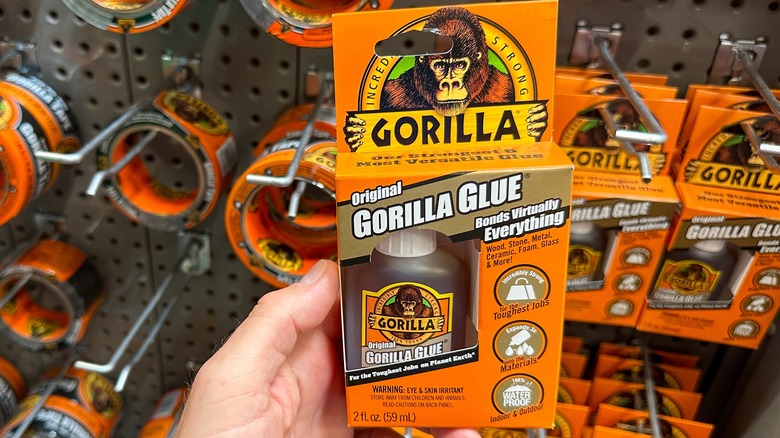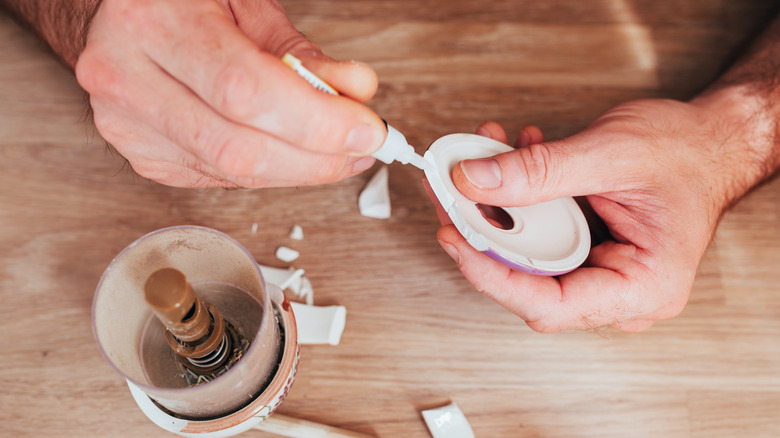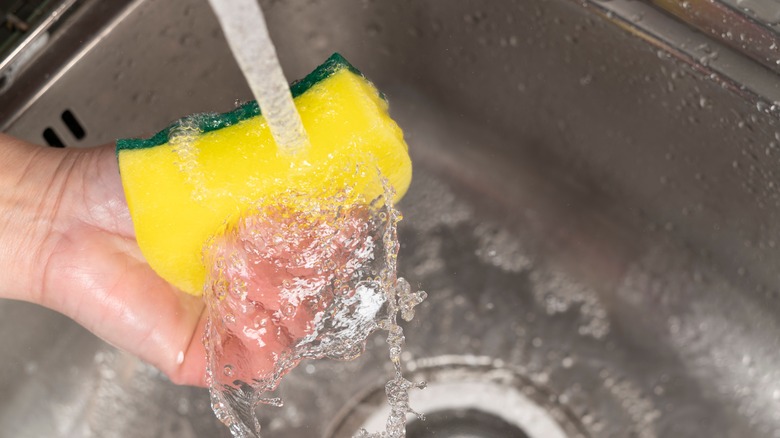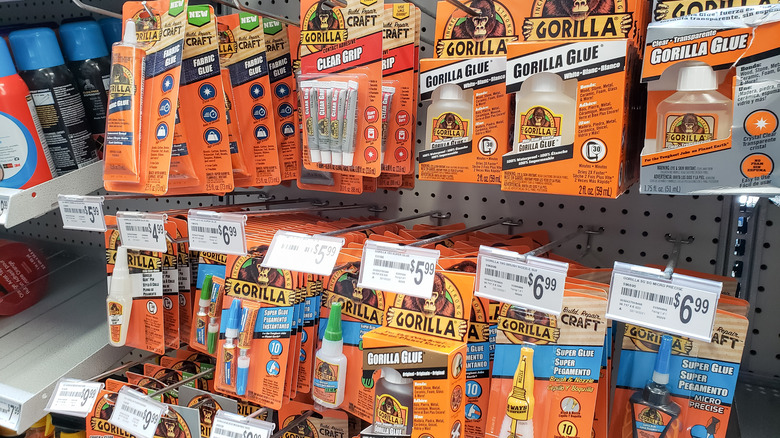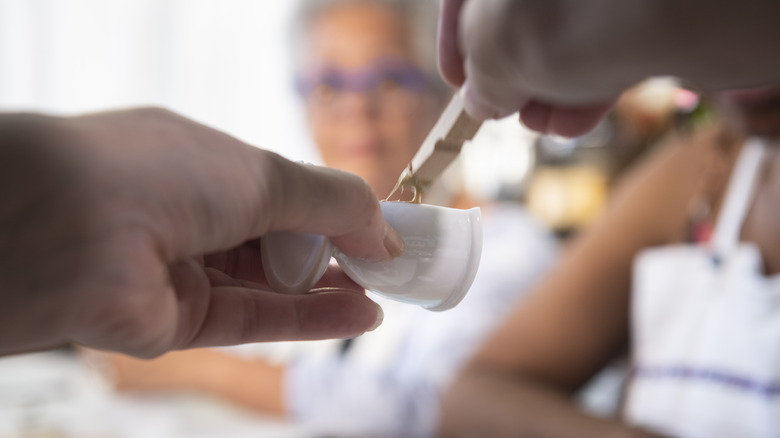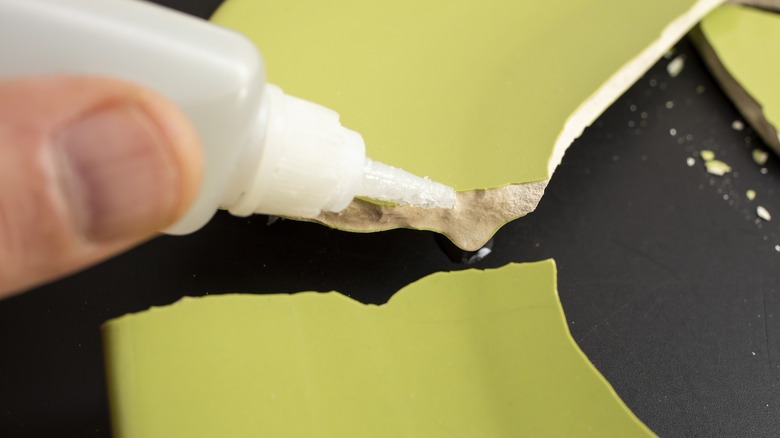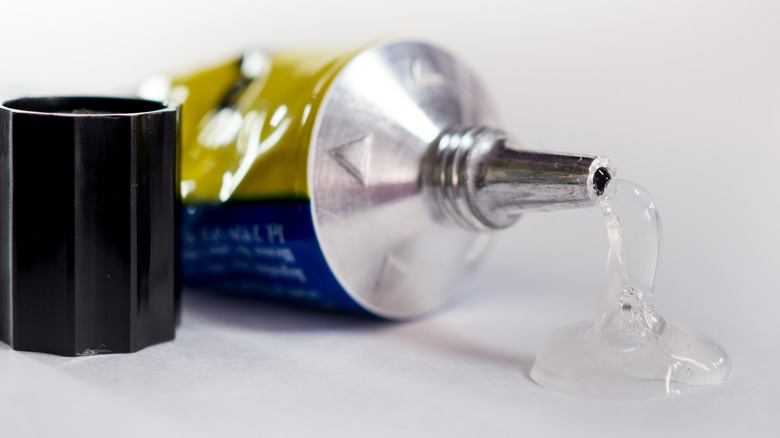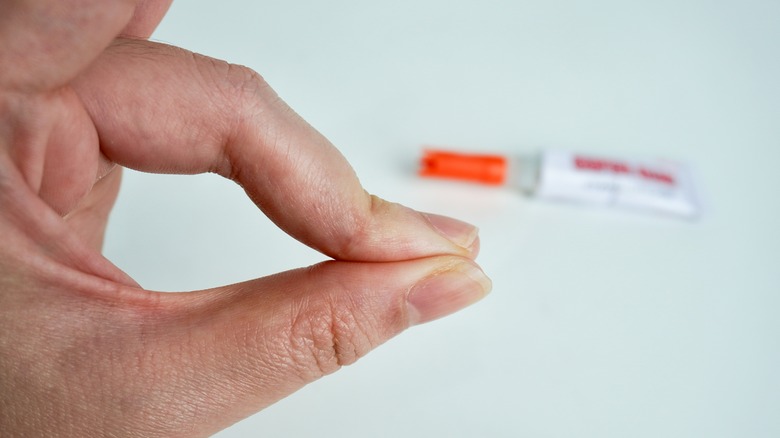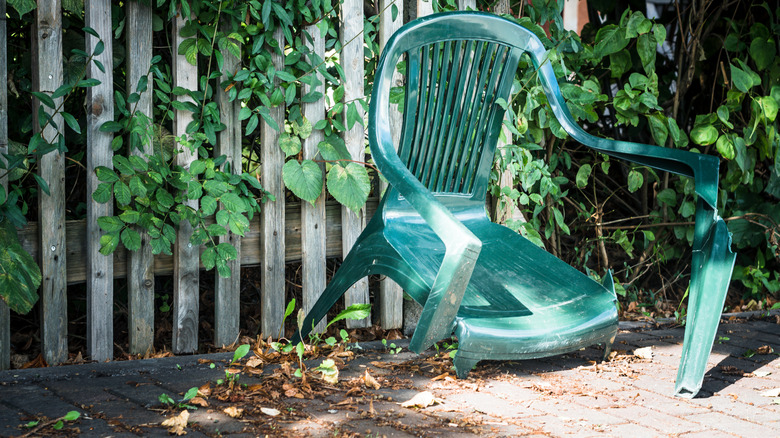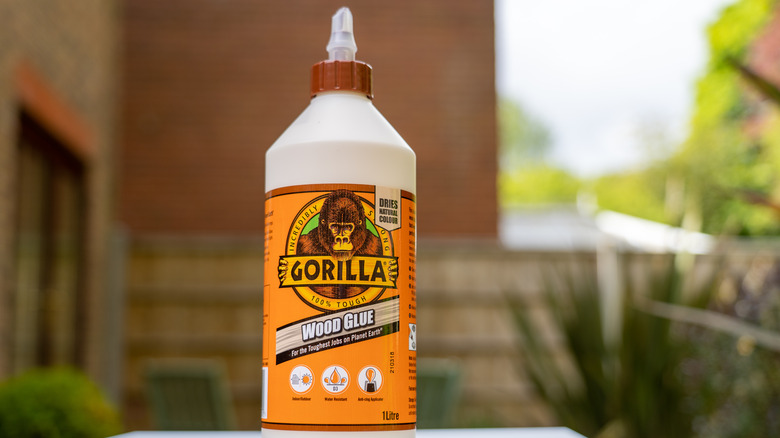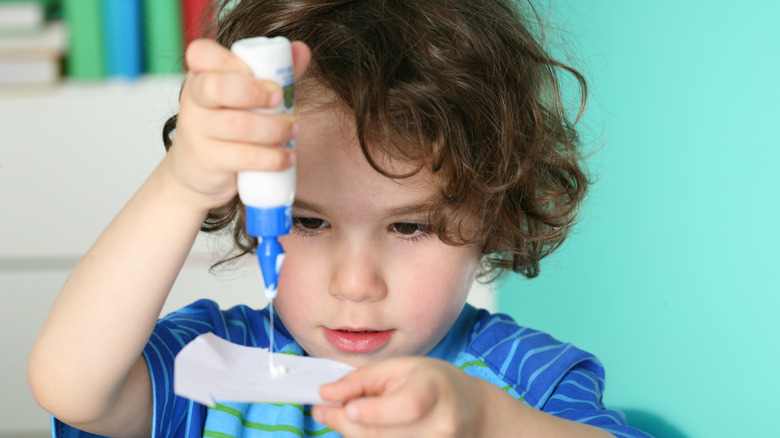Mistakes Everyone Makes When Using Gorilla Glue Around The House
We may receive a commission on purchases made from links.
Whether it's repairing a broken vase or bonding wooden components in a DIY project, Gorilla Glue is many people's go-to solution. This polyurethane adhesive is known for its incredible strength and ability to bind items together. It can be a true lifesaver, making it possible to fix objects that would otherwise be destined for a landfill.
Gorilla Glue is relatively easy to use. With just a few minutes of your time, you can adhere the necessary items to one another and they'll soon be back in the game and ready for use. However, despite the overall simplicity of using this adhesive, there are a few common mistakes people make when working with Gorilla Glue around their home, including using the incorrect formulation, not prepping the surface, or even not storing the glue properly. Understanding these mistakes — and learning what you should do instead — can help you avoid a catastrophe and ensure the application of the strong adhesive is effective.
Skipping the important step of cleaning the surface before applying the glue
Gorilla Glue is known for its strength, which leads many people to believe that it can bond anything without issue. As a result, they often skip important steps in the instructions, such as prepping the surfaces — especially wiping away dust and debris. However, this can lead to major hiccups down the road.
While some dust and debris might seem harmless, they can actually interfere with the adhesion process. Gorilla Glue, like most super glues, is a type of contact adhesive, meaning it bonds to whatever it touches. If the glue sticks to these particles instead of the surfaces you're trying to bond, it reduces the amount of adhesive available to create a strong bond between the two items. Save yourself the frustration of dealing with a project that doesn't remain glued by taking a few minutes to thoroughly clean and prepare the surfaces, as is recommended by the manufacturer.
Forgetting to moisten the surface before applying the glue
Cleaning isn't the only step that many users overlook. If you've ever read the directions on a bottle of Gorilla Glue, then you've probably seen that the manufacturer calls for lightly dampening one of the surfaces you are trying to bond with a little bit of water. Not only might this step seem unnecessary to some, it may also come across as counterintuitive. You might assume that the water will make the glue too runny or prevent it from bonding, causing you to purposely skip this important step.
However, the makers of Gorilla Glue know the product and wouldn't include this step in the directions if it wasn't important. A little bit of moisture is actually important for ensuring that the glue can be cured. The polyurethane adhesives in Gorilla Glue react with the moisture, so, without that touch of water, it might not cure properly, opening up the possibility that your items won't remain bonded. While a bit of moisture is essential, just make sure that you don't go overboard. The manufacturer calls for the surface to be lightly dampened — keyword, lightly. It is recommended to wipe it with a damp cloth or spray a small amount of water on one of the surfaces.
Choosing the wrong formulation of Gorilla Glue for the job
Did you know that there are different types and formulations of Gorilla Glue? If you always use the same bottle for various repairs and DIY projects, you might be making a mistake. Some formulations are better suited for certain jobs, and you're more likely to find lasting success when you choose the right product for the task.
For example, if you're trying to repair a piece of wooden furniture or other wooden items, then you should opt for the Gorilla Wood Glue Ultimate, which is formulated specifically for use on wood. Its special wood glue even offers extended working times without worrying about the glue hardening as you're still working. Other times, when precision is key and you're working on a very small surface area, you'll want to take advantage of the accuracy offered by the Gorilla Micro Precise Super Glue. The tip on this bottle dispenses less glue with each squeeze to help you better control what you're doing.
Applying too much glue
Hindsight is always 20/20. If you've ever used Gorilla Glue unsuccessfully, there are probably many super glue tips and tricks you wish you'd known sooner. One of these is that a little bit of glue goes much farther than you'd probably expect. When your goal is to permanently adhere two items or pieces together, it can be tempting to use a lot of glue. The more the better, right? Wrong.
Gorilla Glue's manufacturer recommends applying a thin layer of the glue when trying to bond two items. In fact, they even say to use about half of what you'd think you'd need (about 1 ounce per square foot or one drop per each 6.5 square centimeters). The glue is very strong, and this is all that is needed for it to bond two items together. If you apply more than the recommended amount, you risk excess glue seeping out between the items you're bonding or dripping onto the surface you're working over. Additionally, it may not bond properly and the glue may take longer to cure.
Thinking clamping the material isn't necessary
Clamping is another one of those directions that many people ignore because they don't think it is going to make a difference or don't have the necessary materials. However, Gorilla Glue strongly recommends following this step. The manufacturer explains that clamping can help ensure the strongest bond possible. The glue expands during the curing process and without putting pressure on the items you're trying to bond together, the line of glue may not remain even. As you can imagine, this can lead to portions of the bond being weaker than others, potentially resulting in the items not remaining adhered to one another.
If you have them, professional clamps are the best tool for this job. They are designed specifically for the purpose of holding items together and will help ensure that the glue can cure evenly. If you regularly complete DIY projects that require the use of Gorilla Glue, you might want to consider investing in a professional clamp, such as the Jorgensen Steel Bar Clamps or Equiptz 6-Inch Spring Clamps. However, if you can't justify the added expense of a clamp or don't have one handy when you need to glue two items together, there are alternative materials that can help you achieve the crucial even pressure distribution. You can try placing a dictionary or another heavy book on top of the two items or wrapping them with some tape to keep them from sliding around while the glue cures.
Not cleaning up spills or excess glue promptly
Working carefully and using the recommended amount of glue will minimize the chance of a spill or excess glue seeping out between the materials you're gluing together. However, that doesn't mean that an accident won't happen or that you won't slip when you're trying to apply the glue and get it somewhere that you don't want it. In these cases, it is essential to clean up the spill or excess adhesive promptly. The manufacturer recommends using a dry cloth or paint thinner to clean up excess glue. Instead of wiping the cloth across the entire surface, make smaller swipes to clean it up.
If you fail to act promptly — or don't realize that the Gorilla Glue spilled before it has already dried — you may still be able to remove it, but it won't be as easy. Once dried, the manufacturer recommends manual removal methods, such as sanding it or scraping it off using a chisel or scraping tool. There are also some super glue removal hacks you can try if the adhesive has gotten on your clothing. You can try applying acetone to the affected area or using a knife to scrape it off. If you're going to apply acetone or any other solutions to your clothing or other fabrics, just be sure to test them in an inconspicuous spot first since they might bleach it.
Failing to protect your skin when working with the glue
There are a few hidden downsides to using super glue to fix things around the house. One of these is the potential of getting the adhesive on your hands or other parts of your body. At best, you're going to be dealing with sticky fingers and the hassle of trying to get the glue off of your skin. The manufacturer highlights the risk of cured glue staining skin for a temporary period of time. Even if it doesn't end up staining your skin, cured Gorilla Glue can still take multiple days to wear off. If it does get on your hands or other parts of your body, follow the manufacturer's directions to keep your skin moisturized to help protect it from damage from the chemicals in the compound.
However, there is an additional concern that some may face. Gorilla Glue states that its product may be a skin sensitizers for some individuals, particularly those who already have more sensitive skin. Skin sensitizers are substances that trigger an allergic reaction. For these people, the reaction could vary from some redness or itchiness to swelling, lesions, or worse. To minimize the chance of anything from a minor frustration to a much more serious reaction, be sure to protect your skin when you're working with Gorilla Glue. Wear gloves, long sleeves, and long pants to prevent the glue from coming into contact with your skin.
Using Gorilla Glue to try to bond polyethylene or polypropylene plastic
Gorilla Glue can be used on a variety of materials, including wood, ceramic, aluminum, steel, and tile. It is even suitable for use on many plastics. However, there are certain types of plastics the manufacturer does not recommend using it on, namely polypropylene (PP) and polyethylene (PE). Ignoring this recommendation and thinking you'll be fine to just use it on PP and PE plastics is a mistake you won't want to make. If you try it, you'll likely find yourself disappointed that the glue didn't adhere properly and experience frustration that the items you were trying to bond remain separated.
The reason Gorilla Glue — and many other types of super glue — don't work with PP and PE plastics is because of the lower surface energy of these plastics compared to that of other materials. Surface energy is essentially a measure of attraction between the molecules of two materials, thus affecting how successfully they can be glued together. This prevents Gorilla Glue from being able to penetrate deep enough to ensure a secure bond. If you need to glue plastics together, you'll want to choose an adhesive specifically designed for such use, such as the Loctite Super Glue Plastics Bonding System.
Not storing it properly
As mentioned earlier, a little bit of Gorilla Glue goes a long way. That means that each bottle should help you complete multiple DIY projects and minor home repairs. That is, so long as you know how to extend the life of the super glue by storing it properly. Improper storage can cause the glue to dry and harden, rendering it useless for that next project. There are actually several storage mistakes that you'll want to avoid.
One of the more obvious mistakes is storing the glue without the lid — or without the lid on correctly. The reason this is such a no-no is due to the moisture in the air. If you'll remember, the glue is activated by moisture, so any water in the air will react with the chemicals and cause it to harden. Similarly, be purposeful about where you store the glue, and opt for a dry place instead of somewhere like a damp basement. This will further limit the risk moisture poses to causing the glue to solidify. When choosing the ideal storage location, you'll also want to choose somewhere that is out of the line of direct sunlight, such as in a closed pantry or tool box. The beating rays of the sun might increase the temperature of the glue, altering its chemical composition and, therefore, its ability to perform as desired.
Leaving Gorilla Glue where children or pets may play with it or eat it
Proper storage of Gorilla Glue is important for more than extending the lifespan of the product — it is essential in preventing accidental harm to any children or pets in the home. Beyond the risk of discoloring the skin or causing a more serious allergic reaction, Gorilla Glue can be extremely dangerous if swallowed. The glue expands as it reacts with moisture in the environment. The stomach of a person or pet is, unsurprisingly, a moist environment. So, if swallowed, the Gorilla Glue will expand, potentially creating a large foreign element in the body.
This foreign element can create a gastrointestinal obstruction. Depending on where the mass forms, it could either block food from being able to enter or exit the stomach, both of which can have serious health implications. Your pet or child will likely need surgery to remove the mass. If you've dealt with a curious child or mischievous pet eating something they shouldn't have eaten before, your first reaction might be to try to induce vomiting. However, this isn't a good idea when Gorilla Glue is consumed, because the expanding mass of glue could become lodged in their throat, cutting off air from being able to enter their lungs. Instead, rush the child or pet to the emergency room (or pet emergency room) to seek immediate care from a physician.
